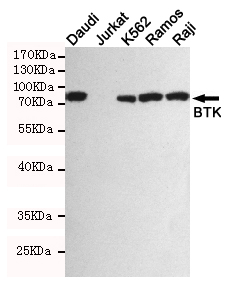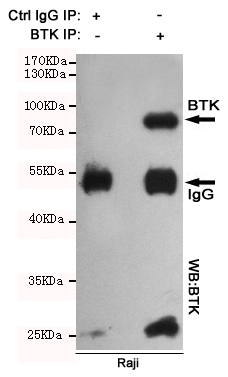-
Product Name
Anti-BTK (5B12) Mouse antibody
- Documents
-
Description
BTK (5B12) Mouse monoclonal antibody
-
Tested applications
WB, IP
-
Species reactivity
Human
-
Alternative names
Agammaglobulinaemia tyrosine kinase;AGMX 1;AGMX1;AT;ATK;B cell progenitor kinase;B-cell progenitor kinase;BPK;Bruton agammaglobulinemia tyrosine kinase;Bruton tyrosine kinase;Bruton's Tyrosine Kinase;Btk;BTK_HUMAN;IMD 1;IMD1;MGC126261;MGC126262;OTTHUMP000 antibody
-
Isotype
Mouse IgG1
-
Preparation
Antigen: Purified recombinant human BTK protein fragments expressed in E.coli.
-
Clonality
Monoclonal
-
Formulation
Purified mouse monoclonal antibody in PBS(pH 7.4) containing with 0.02% sodium azide and 50% glycerol.
-
Storage instructions
Store at 4°C short term. Store at -20°C long term. Avoid freeze / thaw cycle.
-
Applications
WB: 1/1000
-
Validations

Western blot detection of BTK in Daudi,Jurkat(BTK negative),K562,Ramos and Raji cell lysates using BTK mouse mAb (1:1000 diluted).Predicted band size:77KDa.Observed band size:77KDa.

Immunoprecipitation analysis of Raji cell lysates using BTK mouse mAb.
-
Background
Swiss-Prot Acc.Q06187.Non-receptor tyrosine kinase indispensable for B lymphocyte development, differentiation and signaling. Binding of antigen to the B-cell antigen receptor (BCR) triggers signaling that ultimately leads to B-cell activation. After BCR engagement and activation at the plasma membrane, phosphorylates PLCG2 at several sites, igniting the downstream signaling pathway through calcium mobilization, followed by activation of the protein kinase C (PKC) family members. PLCG2 phosphorylation is performed in close cooperation with the adapter protein B-cell linker protein BLNK. BTK acts as a platform to bring together a diverse array of signaling proteins and is implicated in cytokine receptor signaling pathways. Plays an important role in the function of immune cells of innate as well as adaptive immunity, as a component of the Toll-like receptors (TLR) pathway. The TLR pathway acts as a primary surveillance system for the detection of pathogens and are crucial to the activation of host defense. Especially, is a critical molecule in regulating TLR9 activation in splenic B-cells. Within the TLR pathway, induces tyrosine phosphorylation of TIRAP which leads to TIRAP degradation. BTK plays also a critical role in transcription regulation. Induces the activity of NF-kappa-B, which is involved in regulating the expression of hundreds of genes. BTK is involved on the signaling pathway linking TLR8 and TLR9 to NF-kappa-B. Transiently phosphorylates transcription factor GTF2I on tyrosine residues in response to BCR. GTF2I then translocates to the nucleus to bind regulatory enhancer elements to modulate gene expression. ARID3A and NFAT are other transcriptional target of BTK. BTK is required for the formation of functional ARID3A DNA-binding complexes. There is however no evidence that BTK itself binds directly to DNA. BTK has a dual role in the regulation of apoptosis.
Related Products / Services
Please note: All products are "FOR RESEARCH USE ONLY AND ARE NOT INTENDED FOR DIAGNOSTIC OR THERAPEUTIC USE"
